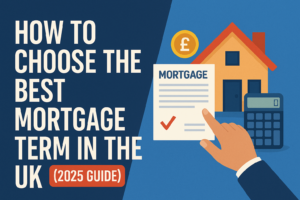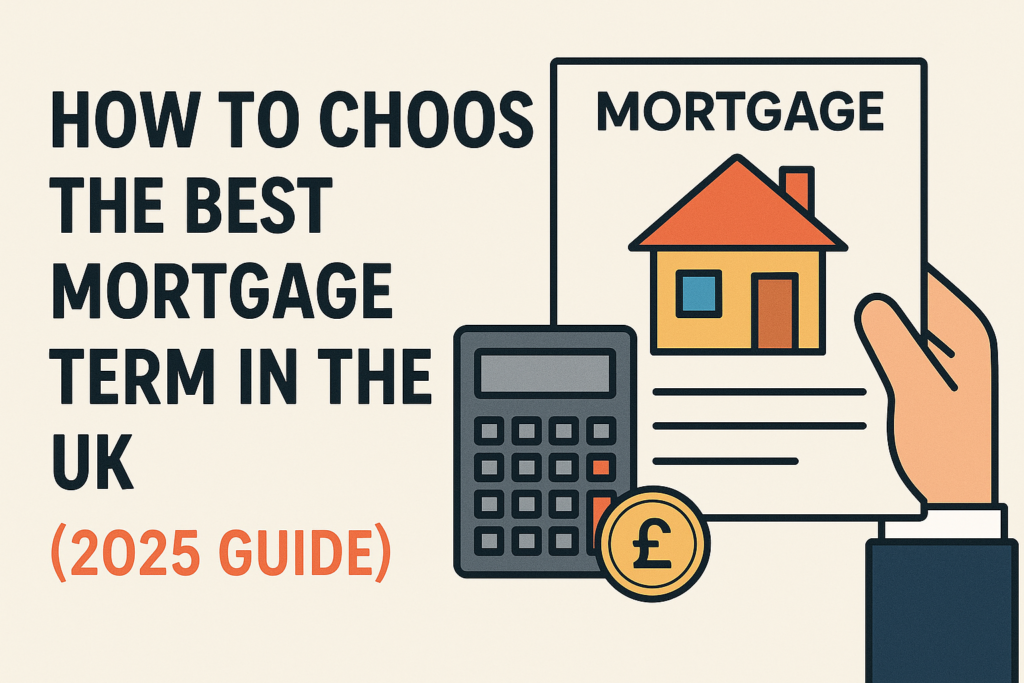 Choosing the right mortgage term is one of the most critical decisions when buying a home or remortgaging in the UK. With mortgage rates fluctuating and the UK property market evolving in 2025, selecting a term that suits your financial situation can save you thousands of pounds over the life of your loan. But how do you decide between a 2-year fixed, a 5-year tracker, or a 30-year mortgage? This comprehensive guide, tailored for UK homebuyers and homeowners, explores everything you need to know about mortgage terms, including types, factors to consider, and practical tips to make an informed choice.
Choosing the right mortgage term is one of the most critical decisions when buying a home or remortgaging in the UK. With mortgage rates fluctuating and the UK property market evolving in 2025, selecting a term that suits your financial situation can save you thousands of pounds over the life of your loan. But how do you decide between a 2-year fixed, a 5-year tracker, or a 30-year mortgage? This comprehensive guide, tailored for UK homebuyers and homeowners, explores everything you need to know about mortgage terms, including types, factors to consider, and practical tips to make an informed choice.
What Is a Mortgage Term?
A mortgage term is the length of time you agree to repay your mortgage loan or the duration of a specific deal (e.g., a fixed-rate period). In the UK, mortgage terms typically range from 2 to 40 years for the overall loan, with shorter “deal” periods (e.g., 2, 5, or 10 years) for fixed or tracker rates. At the end of a deal, you’ll either remortgage to a new deal or revert to the lender’s standard variable rate (SVR), which is often higher.
For example, a 25-year mortgage might start with a 5-year fixed-rate deal. After five years, you’d need to remortgage or switch to the SVR. Choosing the right term—both for the deal and the overall loan—depends on your budget, risk tolerance, and long-term plans.
Types of Mortgage Terms in the UK
Understanding the types of mortgage terms available in 2025 is essential to making the right choice. Here are the main options:
1. Short-Term Mortgage Deals (2–5 Years)
- Fixed-Rate Mortgages: The interest rate remains constant for the deal period (e.g., 2 or 5 years). In 2025, 2-year fixed rates average around 3.5–4.5%, while 5-year fixes range from 4.0–5.0% (based on current market trends).
- Tracker Mortgages: The rate tracks the Bank of England base rate (around 4.5% in 2025) plus a margin (e.g., base rate + 0.5%). These are variable, so payments may fluctuate.
- Pros: Lower initial rates, flexibility to remortgage after the deal ends, ideal for those planning to move or expecting income growth.
- Cons: Higher risk of rate increases (for trackers) and frequent remortgaging costs.
2. Medium-Term Mortgage Deals (5–10 Years)
- Fixed-Rate Mortgages: Offer stability for longer periods, with rates slightly higher than short-term fixes (e.g., 4.2–5.5% for 10 years).
- Pros: Greater payment certainty, fewer remortgaging fees over time.
- Cons: Higher initial rates and potential early repayment charges if you exit early.
3. Long-Term Mortgage Deals (10+ Years)
- Fixed-Rate or Variable: Some lenders offer 10-year fixed rates or longer-term loans up to 40 years.
- Pros: Maximum stability, especially for families or those with fixed budgets.
- Cons: Higher rates and less flexibility if your circumstances change.
4. Overall Mortgage Term
- The total loan term (e.g., 25 or 30 years) affects monthly payments and total interest. Shorter terms mean higher monthly payments but lower total interest; longer terms reduce monthly costs but increase overall interest.
Factors to Consider When Choosing a Mortgage Term
To pick the best mortgage term in 2025, evaluate these key factors:
1. Your Financial Situation
- Income Stability: If you have a stable job or predictable income, a shorter-term deal (2–5 years) offers flexibility. For less certainty (e.g., self-employed), a longer fixed term (5–10 years) provides security.
- Monthly Budget: Longer overall terms (e.g., 30–40 years) lower monthly payments but increase total interest. For example, a £200,000 mortgage at 4% over 25 years costs £1,055/month, but over 35 years, it’s £909/month (use a mortgage calculator to estimate).
- Savings and Debts: High savings or low debt allow you to opt for shorter terms with higher payments to save on interest.
2. Loan-to-Value (LTV) Ratio
- LTV is the loan amount relative to the property’s value. Lower LTV (e.g., 60%) gets better rates than higher LTV (e.g., 95%). For example, in 2025, a 60% LTV mortgage might offer a 3.8% rate, while 95% LTV could be 5.2%.
- Short-term deals are often better for low-LTV borrowers, as they can remortgage easily. High-LTV borrowers may prefer longer fixed terms to lock in rates.
3. Interest Rate Outlook
- In 2025, the Bank of England base rate is around 4.5%, with predictions of slight increases or stability (based on economic forecasts). Tracker mortgages are riskier if rates rise, while fixed-rate deals offer protection.
- If you expect rates to fall, a short-term deal allows you to remortgage at a lower rate later. If rates may rise, a longer fixed term secures your payments.
4. Fees and Costs
- Arrangement Fees: Typically £500–£2,000, these are common with fixed-rate deals. Compare the fee vs. rate savings.
- Early Repayment Charges: Exiting a fixed or tracker deal early (e.g., to sell or remortgage) can cost 1–5% of the loan.
- Valuation and Legal Fees: These add to the cost of remortgaging, so frequent remortgaging (short-term deals) may be less cost-effective.
5. Future Plans
- Moving or Selling: If you plan to move in a few years, a 2-year deal aligns with your timeline.
- Family or Career Changes: Longer terms suit those planning to stay put or expecting stable finances.
- Retirement: Ensure your mortgage term doesn’t extend past retirement age unless you have a repayment plan.
How to Compare Mortgage Terms in 2025
Follow these steps to find the best mortgage term for your needs:
1. Use Comparison Websites
- Platforms like MoneySuperMarket or Compare the Market let you compare rates, fees, and terms from multiple lenders. Enter your loan amount, LTV, and preferred term to see options.
- Example: In 2025, a 2-year fixed mortgage from HSBC might offer 3.9% with a £999 fee, while a 5-year fix from Nationwide is 4.2% with no fee.
2. Consult a Mortgage Broker
- Brokers like Mojo Mortgages or Habito access exclusive deals and provide personalized advice. They can assess whether a short, medium, or long-term deal suits your goals.
- Many brokers offer free services, funded by lender commissions, making them a cost-effective option.
3. Check Lender Websites
- Major UK lenders like Barclays, Lloyds, and Santander list current rates online. Compare fixed vs. tracker rates and check for incentives like cashback or fee-free deals.
- Example: In 2025, some lenders offer “green mortgages” with lower rates for energy-efficient homes.
4. Calculate Total Costs
- Use a mortgage calculator to compare monthly payments and total interest across terms. For a £250,000 loan at 4%:
- 20-year term: £1,515/month, total interest ~£113,600
- 30-year term: £1,193/month, total interest ~£179,280
- Factor in fees to determine the true cost.
5. Assess Your Risk Tolerance
- If you’re comfortable with potential rate increases, a tracker or short-term deal may work. If you prefer certainty, choose a longer fixed term.
Pros and Cons of Different Mortgage Terms
| Term Length | Pros | Cons |
|---|---|---|
| 2–5 Years (Short) | Lower initial rates, flexibility to remortgage, suits short-term plans | Higher risk of rate increases, frequent remortgaging costs |
| 5–10 Years (Medium) | Balance of stability and flexibility, fewer fees than short-term | Slightly higher rates, early repayment charges |
| 10+ Years (Long) | Maximum payment certainty, ideal for fixed budgets | Higher rates, less flexibility if plans change |
| Longer Overall Term (25–40 Years) | Lower monthly payments, easier on budgets | Higher total interest, longer debt period |
Tips to Save Money on Your Mortgage Term
- Overpay When Possible: Many lenders allow overpayments (e.g., 10% of the balance annually) to reduce the term and interest. Check terms to avoid penalties.
- Monitor Rate Trends: Follow economic news or use tools like Bank of England updates to anticipate rate changes.
- Improve Your Credit Score: A better score (check via Experian) unlocks lower rates. Pay bills on time and reduce debt before applying.
- Consider Offset Mortgages: Link your savings to your mortgage to reduce interest, available from lenders like Barclays.
- Review Remortgaging Options: Before your deal ends, compare rates to avoid costly SVRs. Read our Remortgaging Tips to Save UK Money for more.
Common Mistakes to Avoid
- Choosing Based on Rate Alone: Low rates may come with high fees or restrictive terms.
- Ignoring Future Plans: A long-term fix may not suit you if you plan to move soon.
- Overextending Your Budget: Ensure monthly payments are affordable, even if rates rise.
- Not Comparing Lenders: Rates and fees vary widely, so shop around.
Why 2025 Is a Good Time to Choose Wisely
With the UK property market stabilizing in 2025 and interest rates hovering around 4.5%, selecting the right mortgage term is crucial. Shorter terms offer flexibility if rates drop, while longer terms provide security against potential hikes. By comparing options and aligning the term with your goals, you can save significantly over the loan’s life.
For more guidance, explore our First-Time Buyer Mortgage Guide UK or How to Compare Mortgage Rates in the UK to make informed decisions.
Conclusion
Choosing the best mortgage term in the UK for 2025 requires balancing affordability, stability, and flexibility. Short-term deals (2–5 years) suit those expecting income growth or rate drops, while medium (5–10 years) or long-term (10+ years) deals offer predictability for fixed budgets. Use comparison sites, consult brokers, and calculate total costs to find the right fit. By considering your financial situation, LTV, and future plans, you can secure a mortgage term that saves money and supports your homeownership goals.
Disclaimer: Mortgage rates and availability vary. Always consult a qualified financial advisor before making decisions. For the latest rates, visit comparison sites or contact lenders directly.


